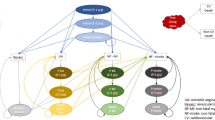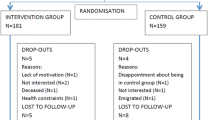Abstract
Background: A low serum level of high-density lipoprotein (HDL)-cholesterol is an independent risk factor for coronary heart disease (CHD). Fibrates, particularly gemfibrozil, have been shown to raise HDL-cholesterol levels and reduce the incidence of CHD. The literature on fibrate cost effectiveness is quite limited.
Objective: The objective of this analysis is to determine the cost effectiveness of the fibrates gemfibrozil and fenofibrate in the primary prevention of CHD. The target population includes patients with low levels of HDL-cholesterol, but without pre-existing CHD or other CHD risk factors sufficiently elevated to indicate drug therapy.
Study design and methods: From a societal perspective, a lifetime incremental cost-effectiveness model was developed to calculate baseline and treatment costs, life-years gained and QALYs gained. Model parameter values were taken from existing literature. In this ‘backward induction’ model, the expected costs and outcomes for each 5-year time-interval are utilised in subsequent 5-year time period calculations over the patient’s entire lifetime. The study population consisted of a hypothetical cohort of males and females in the US aged 45–74 years, with low levels of HDL-cholesterol and no prior history of CHD. The base-case CHD risk factors for this population were obtained from the VA-HIT (Veterans Affairs High-Density Lipoprotein Cholesterol Intervention Trial) population baseline characteristics, but assuming no prior CHD history. Estimates for the reduction in CHD risk associated with fibrate therapy reduction are also taken from the VA-HIT study.
Results: Using a societal cost-effectiveness threshold of $US50 000 per QALY, primary prevention of CHD in patients with low HDL-cholesterol levels using generic gemfibrozil therapy is cost effective for all age and sex categories, in contrast to fenofibrate therapy, which is cost effective for males, but not for females at baseline risks levels. In the base-case scenario, because of their higher CHD lifetime risk, it is more cost effective to treat males than females with either gemfibrozil or fenofibrate. For males and females the cost per QALY decreases with age for most age intervals. Gemfibrozil is more cost effective than fenofibrate for all age-sex categories because of the assumed equal efficacy and the higher fenofibrate drug cost. In the comparison scenario, generic lovastatin was more cost effective than gemfibrozil for men except at age 45 years and women at all ages, and more cost effective than fenofibrate for both men and women.
Conclusions: This analysis suggests that fibrate therapy, particularly with generic gemfibrozil, is cost effective in the primary prevention of CHD in individuals with low HDL-cholesterol levels, with or without elevated triglyceride levels. Certain patient subgroups, such as those with elevated triglyceride levels, smokers and those with diabetes mellitus are likely to achieve both CHD risk reduction and overall savings in net expected medical care costs. Comparable cost-effectiveness results are also shown for lovastatin therapy in the target patient population. Gemfibrozil dominates fenofibrate because of the lower cost of therapy (direct and indirect costs). These conclusions are robust to reasonable changes in model parameter values.


Similar content being viewed by others
Notes
The use of trade names is for product identification purposes only and does not imply endorsement.
References
Heart and stroke statistical update [online]. Available from URL: http//www.americanheart.org/statistics/coronary.html [Accessed 2003 Jul 5]
Castelli QP, Anderson K, Wilson PW, et al. Lipids and risk of coronary heart disease. Ann Epidemiol 1992; 2: 23–8
LaRosa JC, He J, Vupputuri S. Effect of statins on risk of coronary disease: a meta-analysis of randomized controlled trials. JAMA 1999; 282 (24): 2340–6
Frick MIL Elo O, Haapa K, et al. Helsinki Heart Study: primary prevention trial with gemfibrozil in middle aged men with dyslipidemia. N Engl J Med 1987; 317: 1237–45
Rubins HB, Robins SJ, Collins D, et al. Gemfibrozil for the secondary prevention of coronary heart disease in men with low levels of high-density lipoprotein cholesterol. N Engl J Med 1999; 341: 410–8
Kelley MD. Hypercholesterolemia: the cost of treatment in perspective. South Med J 1990; 83: 1421–5
Sarma S, Fifer SK. Gemfibrozil cost-benefit study targeting subgroups for effective hyperlipidaemia drug therapy. Drugs 1990; 40: 42–52
Bergemann R, Brandt A, Siegrist W. Cost-effectiveness study of a lipid lowering therapy in hyperlipoproteinaemia type Ilb and type IV (Frederickson). Pharmacoeconomics 1999; 15: 47–74
Perreault S, Hamilton VH, Lavoie F, et al. A head to head comparison of the cost effectiveness of HMG-CoA reductase inhibitors and fibrates in different types of primary hyperlipidemia. Cardiovasc Drugs Ther 1996; 10: 787–94
Gold, M, Siegel J, Russell L, et al. Cost effectiveness in health and medicine. New York: Oxford University Press, 1996
Nyman J, Martinson M, Nelson D, et al. Cost-effectiveness of gemfibrozil for coronary heart disease patients with low levels of high-density lipoprotein cholesterol: The Department of Veterans Affairs High-Density Lipoprotein Cholesterol Intervention Trial. Arch Intern Med 2002 Jan 28; 162 (2): 177–82
Hay JW, Yu WM, Ashraf T. Pharmacoeconomics of lipidlowering agents for primary and secondary prevention of coronary artery disease. Pharmacoeconomics 1999; 15 (1): 47–74
Anderson KM, Odell PM, Wilson PW, et al. Cardiovascular disease risk profiles. Am Heart J 1990; 121: 293–8
US decennial life tables for 1989–91 [online]. Available from URL: http://www.ede.gov/nchs/data/de89-14.pdf [Accessed 2004 Apr 18]
Prescription price checker [online]. Available from URL: http://www.drugstore.com/pharmacy/prices. [Accessed 2004 Apr 18]
US Department of Labor Bureau of Labor Statistics [online]. Available from URL: http://www.bls.gov. [Accessed 2004 Apr 18]
Downs JR, Clearfield M, Weis S, et al. Primary prevention of acute coronary events with lovastatin in men and women with average cholesterol levels: results of AFCAPS/TexCAPS. JAMA 1998; 279: 1615–22
Wittels EH, Hay JW, Gotto AM. Medical costs of coronary artery disease in the United States. Am J Cardiol 1990; 65: 432–40
Smith CA, Melfi JA, Kesterson BJ, et al. Direct medical charges associated with myocardial infarction in patients with and without diabetes. Med Care 1999; 37 (4): As4–11
Russell MW, Huse DM, Drowns S, et al. Direct medical costs of coronary artery disease in the United States. Am J Cardiol 1998; 81: 1110–5
Anderson RN. United States life tables, 1998. Nall Vital Stat Rep 2001 Feb 7; 48 (18): 1–40
Hay JW. Economic modeling and sensitivity analysis. Value Health 1998; 1: 187–93
Fryback DG, Dasbach EJ, Klein R, et al. The Beaver Dam Health Outcomes Study: initial catalog of health-state quality factors. Med Decis Making 1993; 13: 89–102
Hay J, Wittels E, Gotto A. An economic evaluation of lovastatin for cholesterol lowering and coronary artery disease reduction. Am J Cardiol 1991 Apr 15; 67 (9): 789–96
Garber AM, Phelps CE. Economic foundations of cost-effectiveness analysis. J Health Econ 1997; 16: 1–31
Graham JD, Corso PS, Morris JM, et al. Evaluating the costeffectiveness of clinical and public health measures. Annu Rev Public Health 1998; 19: 125–52
Executive summary of the third report of the National Cholesterol Education Program (NCEP) expert panel on detection, evaluation, and treatment of high blood cholesterol in adults (adult treatment panel III). JAMA 2001; 285 (19): 2486–97
American Diabetes Association. Management of dyslipidemia in adults with diabetes. Diabetes Care 2003; 26 Suppl. 1: S83-6 29. LoFibra® (fenofibrate) prescribing information. Sellersville (PA): Gate Pharmaceuticals, 2003 May
LoFibra® (fenofibrate) prescribing information. Sellersville (PA): Gate Pharmaceuticals, 2003 May
Gemfibrozil prescribing information. Weston (FL): Apotex Corporation, 2001 Nov
Lopid® (gemfibrozil) prescribing information. New York (NY): Pfizer Pharmaceuticals Inc, 2003 Aug
Grundy SM, Pasternak R, Greenland P, et al. Assessment of cardiovascular risk by use of multiple-risk-factor assessment equations: a statement for healthcare professionals from the American Heart Association and the American College of Cardiology. Circulation 1999; 100: 1481–92
Acknowledgements
Dr Hay contributed to the development of the model and writing of this study; he has no real or potential conflicts of interest. Dr Sterling contributed to the development of the model (including literature search) and writing of this study; she has no real or potential conflicts of interest. No research support was sought or obtained for this research. The views are solely those of the authors.
Author information
Authors and Affiliations
Corresponding author
Rights and permissions
About this article
Cite this article
Hay, J.W., Sterling, K.L. Cost effectiveness of treating low HDL-cholesterol in the primary prevention of coronary heart disease. Pharmacoeconomics 23, 133–141 (2005). https://doi.org/10.2165/00019053-200523020-00005
Published:
Issue Date:
DOI: https://doi.org/10.2165/00019053-200523020-00005




